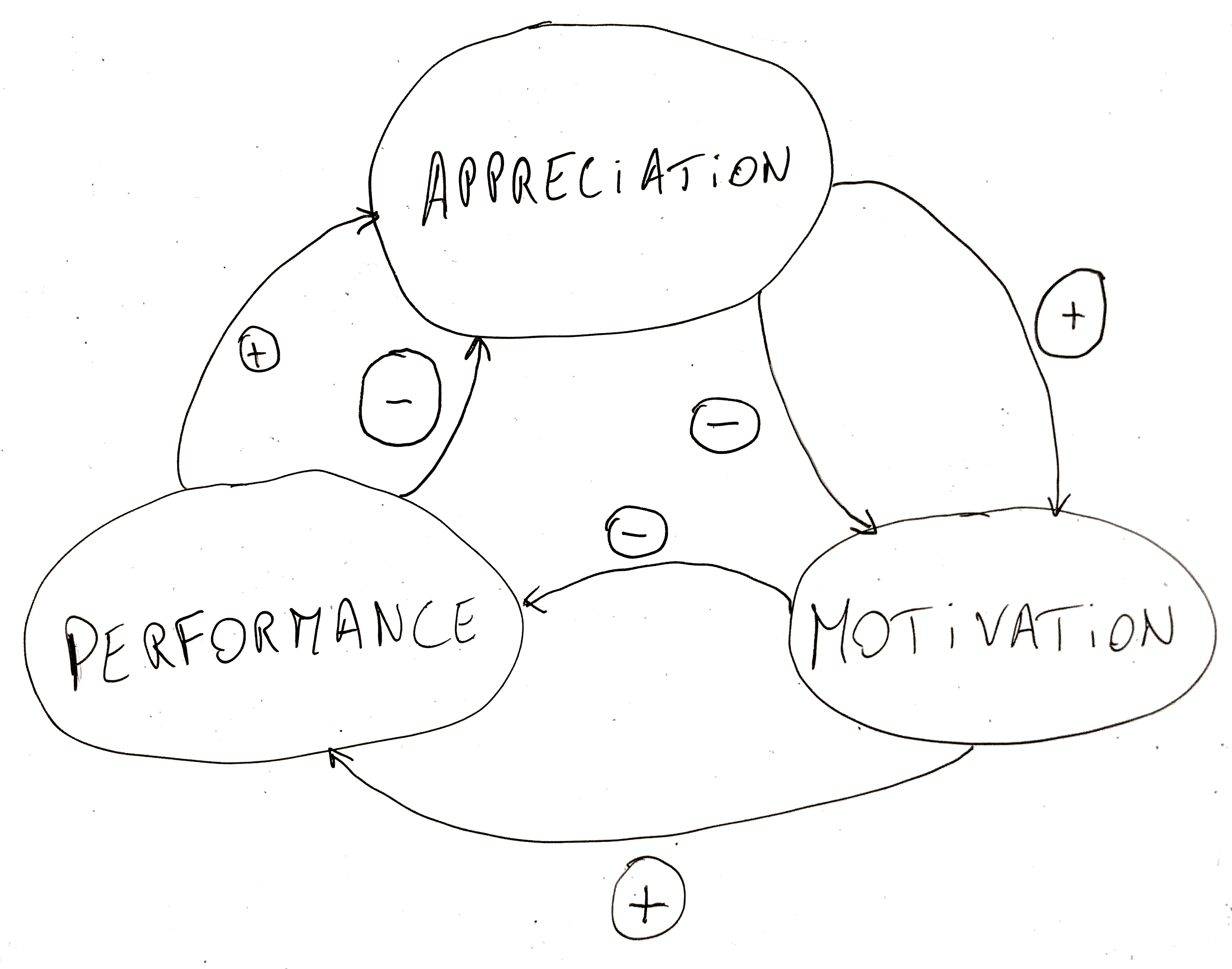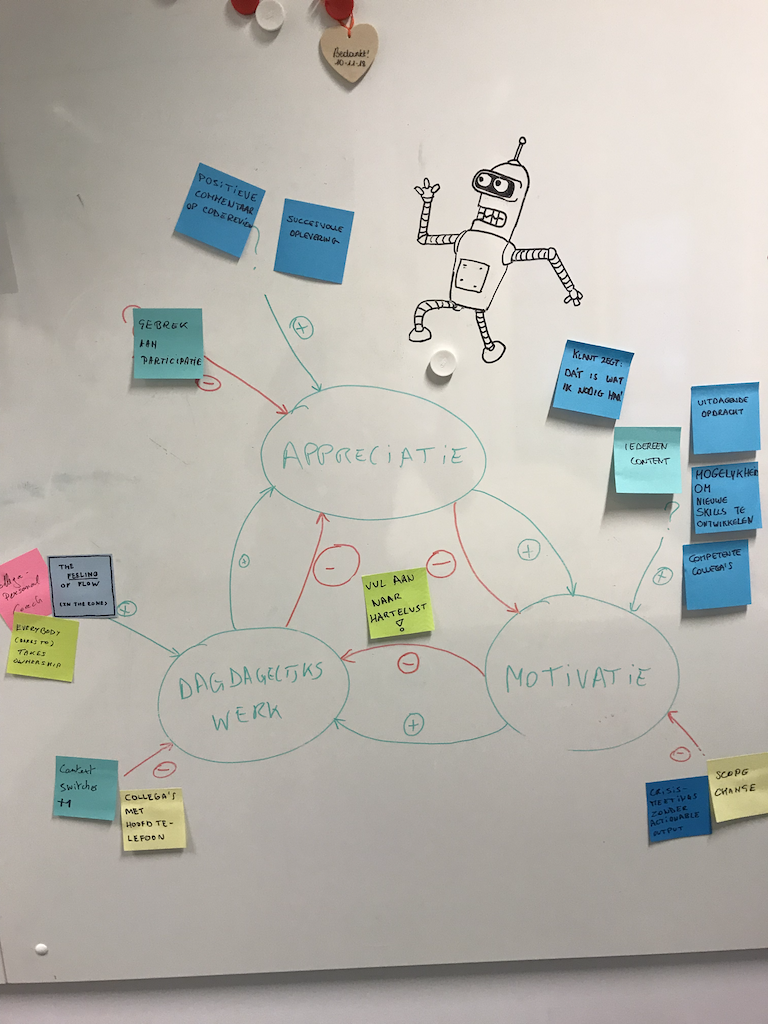 Vicious and Virtuous cycles of Motivation
Vicious and Virtuous cycles of Motivation
20 Mar 2019 •
5 min. read • Read the comments
Tagged
TL;DR
I believe there is both a positive and negative reinforcing feedback loop between appreciation, motivation and performance. And becoming aware of this simple model may help counteract the vicious aspect and strengthen the virtuous one.
If you want to practice using this model and see what other people can come up with, I invite you to join our next Kunlaboratorium. Oh, and here’s the loopy you can play around with.
Conception
The other day I woke up in the middle of the night and I had this urge to write down what I was thinking and see if my morning self also thought this was valuable somehow.
But first some context. I had been thinking a lot about Thinking in Systems recently and was sort of struggling with how to deal with some self-reflection insights I got at work.
This must’ve triggered this thing I had in my head all of a sudden.
Virtuous Motivation Cycle
When I feel Appreciated at work, I get more Motivated. Because I feel more Motivated, I do a better job and will push that little extra. You can say it has a beneficial effect to my Performance at work.
Then, because I’m noticeably more Performant, I’ll get more Appreciation from my colleagues and customers. And so the cycle continues.
Everytime this cycle restarts though, the strength of the positive reinforcement between Performance and Appreciation diminishes. Either because those little extras I put in at work will be expected from me, or because they’ll become less visible.
I’ll call this the Virtuous Motivation Cycle.
Vicious Motivation Cycle
However, there is also a Vicious Motivation Cycle. When I don’t feel Appreciated by my colleagues or customer, I get Demotivated. Which in turn affects my work Performance in a bad way.
I don’t feel like putting in some extra effort, because it will go unnoticed anyways.
Because my work Performance (visibly) lowers, I will get less Appreciated (like a self-fulfilling prophecy). Causing me to feel even more Demotivated, etc.
Everytime this cycle restarts, the strength of the negative reinforcement between Performance and Appreciation increases. This is in stark contrast to the Virtuous Cycle where the Positive effect Diminishes.
If you’ve been nodding your head in agreement to what you’ve been reading I bet you’re dying to find out where I’m going with this. I was too when I woke up in the middle of the night and drew it out. And I thought I’d let morning self figure that out.
Usage
The next morning I looked at what dream self drew overnight and it still seemed to make sense. But what do I do with this knowledge of those reinforcing cycles? When I arrived at work, the first thing I did after making myself a nice cup o’ joe, was to draw it out on the whiteboard next to the lunch tables.
After some impromptu conversations with some of my colleagues and having explained the model, it dawned on me that there are a bunch of different triggers to both cycles, by affecting one of the circles (Appreciation, Motivation, Performance).
For example, when I get positive feedback from a 360 review, this triggers the Virtuous Motivation Cycle starting with Apreciation. Or, when we have to do rework on a feature because I didn’t test it properly enough, it might trigger the Vicious Motivation Cycle starting with Performance.
Interested in what other triggers my colleagues could come up with, I hung up a post-it asking for exactly that. I made an accompanying slack post with a photo of the model and my request to add moar stuff and waited it out.
Here’s what we came up with.
What we see here is an overview of who works at our company and :
- what (de-)motivates them
- how we can make them feel (under-)Appreciated
- and what they need (and don’t need) to do a good job.
Neat huh?!
Other usages
Aside from thinking what can trigger those cycles, you can also take a different perspective and think about what actions or things that can counteract a cycle.
For example, if I notice I’m within a Vicious Cycle, I can use the model to see what positive reinforcing triggers that I know of have an effect on me to start a Virtuous Cycle to counteract the vicious one.
Other things you can do with this is a way of gathering data for your retrospectives. I’ll blog about that properly once I actually performed such a retro myself.
You could also provide this as a basis of self reflection to your colleagues and/or friends.
I’m experimenting with keeping the model up on my wall and every day posting a post-it to learn about how my day went and see if I need to counteract the start of a Vicious Cycle or whether I can make a Virtuous Cycle stronger.
Conclusion
Please keep in mind that the above is nothing but a self-made model. As far as I know there’s no evidence that this works, or research for that matter, that actually verifies the relations or the cycles.
If at any point you notice something wrong with it, I invite you to throw this model away or improve on it.
It’s helped me put some stuff in perspective and my hope is that it can be useful for you too, which is why I’m sharing this.
Thanks for reading to the end, champ! I’d love to hear your thoughts on this, so feel free to leave a comment.

